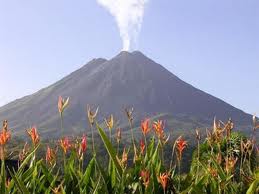Now I will write the next definitions about the following concepts:
·Crust: The crust is the surface layer. It´s thin, solid layer made of rock.
·Mantle: This layer is the intermediate layer is almost 85% of the Earth´s volume.
·Core: The core is the deepest layer.
·Magma: Is molten rock.
What temperature can be reached in the core of the Earth?
It can reach 4.500ºc.
Who was Alfred Wegener? What is Pangaea?
He made the pangaea theory. According to this theory, 200 millions years ago there was a single continent called Pangaea and it was surrounded by a single ocean called Tethys Sea.
The Pangaea broke up, forming the continents. These continents are not fixed, but they are moving, because the crust is divided into several plates, called tectonic plates.
The relationship between tectonic plates and earthquakes:
The tectonic plates are not fixed, and they are moving slowly over the mantle. When a plate collides with another one earthquakes and eruptions of volcanoes are caused. The most important tectonic plates of the Earth are the Euroasian plate, the African plate, the North American and South American plates.
How many continents do we have in planet Earth?
Earth has six continents: Asia, America, Europe, Antartica, Africa and Oceania
The most important oceans of the world:
The Pacific Ocean, the Atlanctic Ocean, the Indian Ocean, the Arctic Ocean, Souther Ocean.
The relief is the result of Internal Forces and External Agents. Now I will write an example of the action of internal forces. I will name the external agents that cause the erosion and modeling of the Earth´s relief.
The relief is the result of the internal forces of the Earth, like plate movements, volcanoes and earthquakes, and external agents are wind, rain, rivers and lakes. The internal forces are responsible for the origin and the elevation of topography and external agents cause the erosion and the modeling of the Earth´s relief.
Now I will write definitions for the following concepts, and I will paste some images related to those definitons. ·Mountain: A mountain is a land mass that rises high above the area around it.
·Plain: Plains are large flat tracts of land.
·Valley: They are sunken land and they are surrounded by mountains. In valleys rivers can flow.
·Plateaux: Plateaux are large areas of high land. They are higher than plains.
·River: A river is a natural stream of water that flows in a channel.
·Delta: Low-lying plain composed of stream-borne sediments deposited by a river in it´s mouth.
·Estuary: A flow of water in a channel, like a small river.
·Glacier: A glacier is a large mass of ice.
·Groundwater: Is water that occurs below the surface of the Earth
·Lake: Lakes are standing waters that occupy an inland basyn.
What is a volcanic eruption? What consecuences does it have?
A volcanic eruption is a huge eruption of ash, melted rock and smelly gases. A volcano forms above the ground. However the eruption of a volcano is a single event. Along with an eruption, comes major destruction.
An earthquake is caused by the movement of tectonic plates.



No hay comentarios:
Publicar un comentario